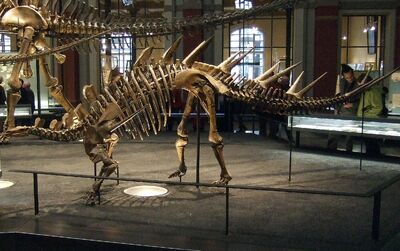
Kentrosaurus
Kentrosaurus is a genus of stegosaurid dinosaur from the Late Jurassic of Tanzania. Its fossils have been found only in the Tendaguru Formation of Tanzania, dated to the Kimmeridgian stage, between about 155.7 ± 4 Ma and 150.8 ± 4 Ma (million years ago). Apparently, all finds belong to one species, K. aethiopicus Hennig 1915.
Kentrosaurus was described by German palaeontologist Edwin Hennig in 1915. Often thought to be a primitive member of the Stegosauria, several recent cladistic analyses find it to be derived, and a close relative to Stegosaurus from the North American Morrison Formation.
Kentrosaurus generally measured around 4.5 meters (15 ft) in length as an adult, probably had a double row of small plates and spikes running down its back, and could use its tail as a "thagomizer" for defense.
Description[]
Body size and posture[]
[1][2]Size compared to a human
Kentrosaurus aethiopicus was a small stegosaur, smaller than Stegosaurus armatus, Hesperosaurusmjosi, Dacentrurus armatus and Tuojiangosaurus multispinus, and about as large as Huayangosaurus taibaii. The total length of a composite skeletal mount in the Museum für Naturkunde Berlin, Germany, from the tip of the snout to the tip of the tail is 4.5 m (15 ft). Slightly more than half of this length is made up by the tail.[1] Larger single elements were found,[2] so that the animal could probably attain a total length of 5.5 m (18 ft).
The long tail of Kentrosaurus results in a position of the center of mass that is unusually far back for a quadrupedal animal. It rests just in front of the hip, a position usually seen in bipedaldinosaurs. However, the femora are straight in Kentrosaurus, as opposed to typical bipeds, indicating a straight and vertical limb position. Thus, the hind feet did not support the animal alone, and the fore feet took up 10 to 15% of the bodyweight. The posterior position of the center of mass may not have been advantageous for rapid locomotion, but meant that the animal could quickly rotate around the hips by pushing sideways with the arms, keeping the tail pointing at threats.
Autapomorphies[]
Kentrosaurus can be distinguished from other members of the Stegosauria by a number of osteological characters. Most notably, the neural spines in the tail are not sub-parallel, as in most dinosaurs. In the anterior third of the tail, they point backwards, the usual direction. In the middle tail, however, they are almost vertical, and further back they are hook-shaped and point forward. Also typical are, among other features, that the dorsal vertebrae have a neural arch more than twice as high as the centrum, and completely occupied by the extremely spacious neural canal. The preacetabular process of the ilium widens laterally, and does not taper.
Armor[]
The elements of the dermal armor of Kentrosauruswere, aside from a few exceptions, not found in close association with other skeletal remains. Thus, the exact position of most osteoderms is uncertain. A pair of closely spaced spikes was found articulated with a tail tip, and a number of spikes were found apparently regularly spaced in pairs along the path of an articulated tail.[2] Hennig and Janensch, while grouping the dermal armour elements into four distinct types, recognized an apparently continuous change of shape among them, suggesting an uninterrupted distribution along the entire body. Because all elements were found in two symmetrical forms, the dermal armour appears to have been placed in at least two parallel rows, although an alternating placement is theoretically possible.